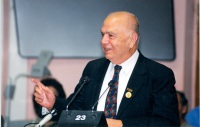ST. MARY'S CITY, Md. - The 13th Annual Holocaust & Genocide Lecture Series at St. Mary's College of Maryland (SMCM) explores "Armenia: The Forgotten Genocide" with two lectures, on Monday, March 26 and Wednesday, March 28 at 8 p.m. At the beginning of the twentieth century, the government of the Ottoman Empire (present day Turkey) massacred and forcibly removed an estimated one million Armenians. Both events are free and open to the public.
 The series begins on Monday, March 26 at 8 p.m. in Daugherty-Palmer Commons, with Susan Vartanian Barba's "Still Alive: The Story of My Father, a Survivor." Vartanian will talk about her father's fate as a survivor of the Armenian genocide and also about their relationship. Vartanian currently lives in New Jersey and is active in the Armenian community. Her talk will be accompanied by a brief segment of a film made about her father. This event will be introduced by Kate Norlock, professor of philosophy.
The series begins on Monday, March 26 at 8 p.m. in Daugherty-Palmer Commons, with Susan Vartanian Barba's "Still Alive: The Story of My Father, a Survivor." Vartanian will talk about her father's fate as a survivor of the Armenian genocide and also about their relationship. Vartanian currently lives in New Jersey and is active in the Armenian community. Her talk will be accompanied by a brief segment of a film made about her father. This event will be introduced by Kate Norlock, professor of philosophy.
 On Wednesday, March 28 in the Campus Center's Cole Cinema, Richard Hovannisian, an international expert on Armenian history, will speak on the political and historical context of the genocide. Hovannisian is professor of Armenian and Near Eastern History at UCLA. Author of multiple books on Armenian history and the genocide, he has also recently served as consultant for National Geographic on a feature article on Armenia. The talk is accompanied by a short video.
On Wednesday, March 28 in the Campus Center's Cole Cinema, Richard Hovannisian, an international expert on Armenian history, will speak on the political and historical context of the genocide. Hovannisian is professor of Armenian and Near Eastern History at UCLA. Author of multiple books on Armenian history and the genocide, he has also recently served as consultant for National Geographic on a feature article on Armenia. The talk is accompanied by a short video.
The deportations and massacres of the Armenian population in Turkey mark the beginning of modern genocidal policies at the beginning of the twentieth century. Responding to the decline of the Ottoman Empire, a nationalist revolutionary group called the Young Turks seized power in 1908 and followed a political ideology of an exclusively Turkish state, in which Armenians were denied a place. An estimated one million Armenians perished through brutal massacres, killings, and death marches disguised as resettlement programs. Hundreds of thousands became homeless and stateless refugees. By 1923, almost the entire Armenian population of Anatolian Turkey had disappeared.


